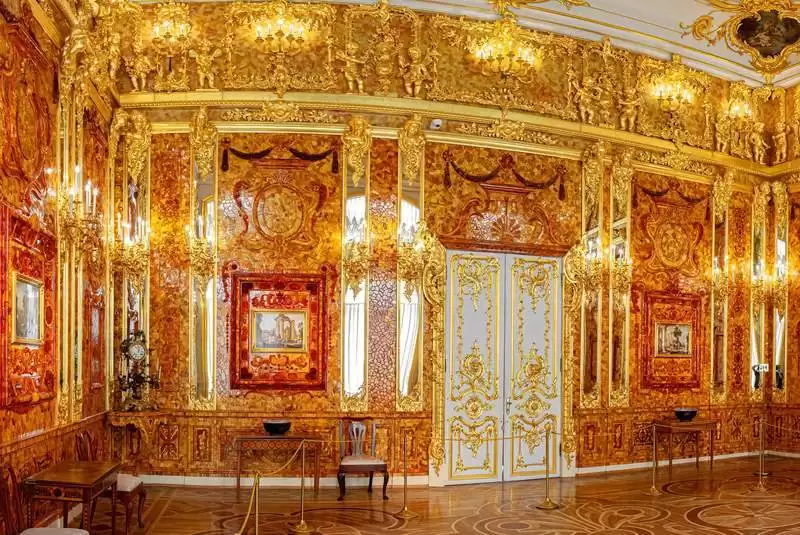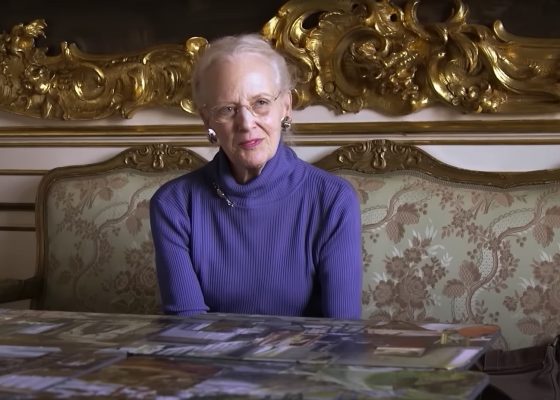
By Zhihui Zou
In 2004, British journalists Catherine Scott-Clark and Adrian Levy wrote in their book The Amber Room: The Fate of the World’s Greatest Lost Treasure that, according to their investigation, the historical architecture, called the Amber Room, was destroyed during the Soviet Red Army’s attack on the Königsberg Castle during World War Two.
Scott-Clark and Levy’s thesis was denied by Russian officials at the time of publication. This might not be caused by the Russian officials’ protectiveness toward their own country’s lost architecture but the general uncertainty and the lack of concrete and direct information about the Amber Room. Many historians and researchers have presented their theses about the whereabouts of the Amber Room after World War Two, but none can convince the world.

The Amber Room was a chamber constructed mainly using amber panels decorated by gold leaves, gemstones, and mirrors. Over six tons of amber and gems were used for its construction. According to the currency in 2007, had the Amber Room survived, it would be worth around $142 million dollars, and over $500 million dollars in 2016, reported the Smithsonian Magazine and United Press International.
The construction of the Amber Room began in 1701, under the lead of the designer, the German sculptor Andreas Schlüter and the Danish amber craftsman Gottfried Wolfram. The chamber became a showpiece chamber for King Frederick William I of Prussia and was installed at Charlottenburg Palace in current day Berlin. The golden color of the room made the Prussian Empire an even shinier star among many European nations.
More than a decade later, Peter the Great, Czar of the Russian Empire, praised the Room for the brilliance in its craftsmanship. As a result, Frederick I gifted the Amber Room to Peter the Great to strengthen the Prussia-Russia alliance against Sweden.
The Amber Room was carefully disassembled and reassembled at Catherine Palace, a summer residence at Pushkin for tzars about 30 miles outside of St. Petersburg, under the orders of Czarina Elizabeth.
Elizabeth loved the chamber. She used it as her personal meditation room. Later, she employed the Italian architect Bartolomeo Francesco Rastrelli to renovate the chamber, using additional amber and gems. The Italian architect incorporated an easily recognizable late Baroque style. After Rastrelli’s renovation, the chamber reached the staggering worth mentioned before, $142 million in 2006’s currency.
Not only Elizabeth enjoyed the chamber. Many other czars used the Amber Room as a reception room for foreign guests, a gathering center for Catherine the Great, and a trophy place for Alexander II, an amber connoisseur.
Even during the turmoil of many revolutions, wars, and changes in the political system, the Amber Room had survived. However, it did not survive the Germans, posterity of the chamber’s original creator.
During World War Two, Adolf Hitler initiated Operation Barbarossa, sending around three million German soldiers into the Soviet Union. Countless Russian artifacts were looted during the war. Hitler was knowledgeable of the Amber Room’s history, and he believed that the artwork should be returned to its actual owners. As a result, he ordered SS soldiers to dismantle the chamber and ship it away.
Anatoly Kuchumov, the art curator at Pushkin at the time, had attempted to save the chamber before the Nazi’s arrival. But Kuchumov believed that moving the chamber would cause catastrophic destruction to the artwork due to the amber’s brittleness over time. He then hid it behind walls, but SS soldiers still discovered the artifact.
In 1941, German troops reached the Catherine Palace. SS soldiers dismantled the chamber in 36 hours and shipped the chamber to Königsberg, Germany, and reassembled it at the Königsberg Castle along with other art displays. The chamber remained there for two years, until Hitler ordered it to be protected in 1944 against Allied bombing and the advancement of the Soviet Red Army.
During the chaos between the British Royal Air Force’s bombing and Soviet artillery during their advancement, the Königsberg Castle was badly damaged. Alfred Rohde, director of Königsberg’s art museum, was the manager of the exhibition that the Amber Room was a part of. No one knows what Rohde had done to the chamber in 1944 and 1945 amid the warfare. What is certain is that the chamber completely disappeared when Soviet soldiers entered the city of Königsberg. Rohde died in December 1945, taking the secrets about the chamber to his grave. The Königsberg Castle was the chamber’s last known location.
The search for the chamber began immediately after the war and extended into today. Researchers both of the 20th and 21st centuries constructed many theories, such as it was destroyed during the bombing, destroyed by Soviet artillery, secretly shipped away from the Königsberg Castle by the Nazis, or hidden in an undiscovered location underground.
World War Two marked the end to the brilliant life of the chamber.

In 1979, the Soviet government ordered the reconstruction of the Amber Room at its original location in Russia, Pushkin. The reconstruction process would later take 24 years, a huge sum of money, and the collaboration of both Russian and German experts and artisans.
Currently, the reconstruction of the Amber Room is installed at the Catherine Palace, open for tourists from around the world.











Cancel anytime


Using our website
You may use the The Middle Land website subject to the Terms and Conditions set out on this page. Visit this page regularly to check the latest Terms and Conditions. Access and use of this site constitutes your acceptance of the Terms and Conditions in-force at the time of use.
Intellectual property
Names, images and logos displayed on this site that identify The Middle Land are the intellectual property of New San Cai Inc. Copying any of this material is not permitted without prior written approval from the owner of the relevant intellectual property rights.
Requests for such approval should be directed to the competition committee.
Please provide details of your intended use of the relevant material and include your contact details including name, address, telephone number, fax number and email.
Linking policy
You do not have to ask permission to link directly to pages hosted on this website. However, we do not permit our pages to be loaded directly into frames on your website. Our pages must load into the user’s entire window.
The Middle Land is not responsible for the contents or reliability of any site to which it is hyperlinked and does not necessarily endorse the views expressed within them. Linking to or from this site should not be taken as endorsement of any kind. We cannot guarantee that these links will work all the time and have no control over the availability of the linked pages.
Submissions
All information, data, text, graphics or any other materials whatsoever uploaded or transmitted by you is your sole responsibility. This means that you are entirely responsible for all content you upload, post, email or otherwise transmit to the The Middle Land website.
Virus protection
We make every effort to check and test material at all stages of production. It is always recommended to run an anti-virus program on all material downloaded from the Internet. We cannot accept any responsibility for any loss, disruption or damage to your data or computer system, which may occur while using material derived from this website.
Disclaimer
The website is provided ‘as is’, without any representation or endorsement made, and without warranty of any kind whether express or implied.
Your use of any information or materials on this website is entirely at your own risk, for which we shall not be liable. It is your responsibility to ensure any products, services or information available through this website meet your specific requirements.
We do not warrant the operation of this site will be uninterrupted or error free, that defects will be corrected, or that this site or the server that makes it available are free of viruses or represent the full functionality, accuracy and reliability of the materials. In no event will we be liable for any loss or damage including, without limitation, loss of profits, indirect or consequential loss or damage, or any loss or damages whatsoever arising from the use, or loss of data, arising out of – or in connection with – the use of this website.
Last Updated: September 11, 2024
New San Cai Inc. (hereinafter “The Middle Land,” “we,” “us,” or “our”) owns and operates www.themiddleland.com, its affiliated websites and applications (our “Sites”), and provides related products, services, newsletters, and other offerings (together with the Sites, our “Services”) to art lovers and visitors around the world.
This Privacy Policy (the “Policy”) is intended to provide you with information on how we collect, use, and share your personal data. We process personal data from visitors of our Sites, users of our Services, readers or bloggers (collectively, “you” or “your”). Personal data is any information about you. This Policy also describes your choices regarding use, access, and correction of your personal information.
If after reading this Policy you have additional questions or would like further information, please email at middleland@protonmail.com.
PERSONAL DATA WE COLLECT AND HOW WE USE IT
We collect and process personal data only for lawful reasons, such as our legitimate business interests, your consent, or to fulfill our legal or contractual obligations.
Information You Provide to Us
Most of the information Join Talents collects is provided by you voluntarily while using our Services. We do not request highly sensitive data, such as health or medical information, racial or ethnic origin, political opinions, religious or philosophical beliefs, trade union membership, etc. and we ask that you refrain from sending us any such information.
Here are the types of personal data that you voluntarily provide to us:
As a registered users or customers, you may ask us to review or retrieve emails sent to your business. We will access these emails to provide these services for you.
We use the personal data you provide to us for the following business purposes:
Information Obtained from Third-Party Sources
We collect and publish biographical and other information about users, which we use to promote the articles and our bloggers who use our sites. If you provide personal information about others, or if others give us your information, we will only use that information for the specific reason for which it was provided.
Information We Collect by Automated Means
Log Files
The site uses your IP address to help diagnose server problems, and to administer our website. We use your IP addresses to analyze trends and gather broad demographic information for aggregate use.
Every time you access our Site, some data is temporarily stored and processed in a log file, such as your IP addresses, the browser types, the operating systems, the recalled page, or the date and time of the recall. This data is only evaluated for statistical purposes, such as to help us diagnose problems with our servers, to administer our sites, or to improve our Services.
Do Not Track
Your browser or device may include “Do Not Track” functionality. Our information collection and disclosure practices, and the choices that we provide to customers, will continue to operate as described in this Privacy Policy, whether or not a “Do Not Track” signal is received.
HOW WE SHARE YOUR INFORMATION
We may share your personal data with third parties only in the ways that are described in this Privacy Policy. We do not sell, rent, or lease your personal data to third parties, and We does not transfer your personal data to third parties for their direct marketing purposes.
We may share your personal data with third parties as follows:
There may be other instances where we share your personal data with third parties based on your consent.
HOW WE STORE AND SECURE YOUR INFORMATION
We retain your information for as long as your account is active or as needed to provide you Services. If you wish to cancel your account, please contact us middleland@protonmail.com. We will retain and use your personal data as necessary to comply with legal obligations, resolve disputes, and enforce our agreements.
All you and our data are stored in the server in the United States, we do not sales or transfer your personal data to the third party. All information you provide is stored on a secure server, and we generally accepted industry standards to protect the personal data we process both during transmission and once received.
YOUR RIGHTS/OPT OUT
You may correct, update, amend, delete/remove, or deactivate your account and personal data by making the change on your Blog on www.themiddleland.com or by emailing middleland@protonmail.com. We will respond to your request within a reasonable timeframe.
You may choose to stop receiving Join Talents newsletters or marketing emails at any time by following the unsubscribe instructions included in those communications, or you can email us at middleland@protonmail.com
LINKS TO OTHER WEBSITES
The Middle Land include links to other websites whose privacy practices may differ from that of ours. If you submit personal data to any of those sites, your information is governed by their privacy statements. We encourage you to carefully read the Privacy Policy of any website you visit.
NOTE TO PARENTS OR GUARDIANS
Our Services are not intended for use by children, and we do not knowingly or intentionally solicit data from or market to children under the age of 18. We reserve the right to delete the child’s information and the child’s registration on the Sites.
PRIVACY POLICY CHANGES
We may update this Privacy Policy to reflect changes to our personal data processing practices. If any material changes are made, we will notify you on the Sites prior to the change becoming effective. You are encouraged to periodically review this Policy.
HOW TO CONTACT US
If you have any questions about our Privacy Policy, please email middleland@protonmail.com
The Michelin brothers created the guide, which included information like maps, car mechanics listings, hotels and petrol stations across France to spur demand.
The guide began to award stars to fine dining restaurants in 1926.
At first, they offered just one star, the concept was expanded in 1931 to include one, two and three stars. One star establishments represent a “very good restaurant in its category”. Two honour “excellent cooking, worth a detour” and three reward “exceptional cuisine, worth a
Thank you for your participation,
please Log in or Sign up to Vote

123Sign in to your account